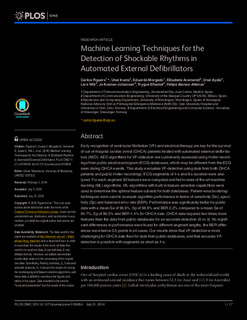| dc.rights.license | Attribution-NonCommercial-NoDerivatives 4.0 International | * |
| dc.contributor.author | Ayala, Unai | |
| dc.contributor.other | Figuera, Carlos | |
| dc.contributor.other | Irusta, Unai | |
| dc.contributor.other | Morgado, Eduardo | |
| dc.contributor.other | Aramendi, Elisabete | |
| dc.contributor.other | Wik, Lars | |
| dc.contributor.other | Kramer-Johansen, Jo | |
| dc.contributor.other | Eftestøl, Trygve | |
| dc.contributor.other | Alonso-Atienza, Felipe | |
| dc.date.accessioned | 2019-05-23T13:54:19Z | |
| dc.date.available | 2019-05-23T13:54:19Z | |
| dc.date.issued | 2016 | |
| dc.identifier.issn | 1932-6203 | en |
| dc.identifier.other | https://katalogoa.mondragon.edu/janium-bin/janium_login_opac.pl?find&ficha_no=125971 | en |
| dc.identifier.uri | https://hdl.handle.net/20.500.11984/1223 | |
| dc.description.abstract | Early recognition of ventricular fibrillation (VF) and electrical therapy are key for the survivalof out-of-hospital cardiac arrest (OHCA) patients treated with automated external defibrilla-tors (AED). AED algorithms for VF-detection are customarily assessed using Holter record-ings from public electrocardiogram (ECG) databases, which may be different from the ECGseen during OHCA events. This study evaluates VF-detection using data from both OHCApatients and public Holter recordings. ECG-segments of 4-s and 8-s duration were ana-lyzed. For each segment 30 features were computed and fed to state of the art machinelearning (ML) algorithms. ML-algorithms with built-in feature selection capabilities wereused to determine the optimal feature subsets for both databases. Patient-wise bootstraptechniques were used to evaluate algorithm performance in terms of sensitivity (Se), speci-ficity (Sp) and balanced error rate (BER). Performance was significantly better for publicdata with a mean Se of 96.6%, Sp of 98.8% and BER 2.2% compared to a mean Se of94.7%, Sp of 96.5% and BER 4.4% for OHCA data. OHCA data required two times morefeatures than the data from public databases for an accurate detection (6 vs 3). No signifi-cant differences in performance were found for different segment lengths, the BER differ-ences were below 0.5-points in all cases. Our results show that VF-detection is morechallenging for OHCA data than for data from public databases, and that accurate VF-detection is possible with segments as short as 4-s. | es |
| dc.language.iso | eng | en |
| dc.publisher | PLOS | en |
| dc.rights | © Figuera et al. | en |
| dc.rights.uri | http://creativecommons.org/licenses/by-nc-nd/4.0/ | * |
| dc.title | Machine Learning Techniques for the Detection of Shockable Rhythms in Automated External Defibrillators | en |
| dc.type | http://purl.org/coar/resource_type/c_6501 | |
| dcterms.accessRights | http://purl.org/coar/access_right/c_abf2 | en |
| dcterms.source | PLoS ONE | en |
| local.description.peerreviewed | true | en |
| local.identifier.doi | http://dx.doi.org/10.1371/journal.pone.0159654 | en |
| local.source.details | Vol. 11. Nº 7. July 21, 2016 | eu_ES |
| oaire.format.mimetype | application/pdf | |
| oaire.file | $DSPACE\assetstore | |
| oaire.resourceType | http://purl.org/coar/resource_type/c_6501 | en |
| oaire.version | http://purl.org/coar/version/c_970fb48d4fbd8a85 | en |








